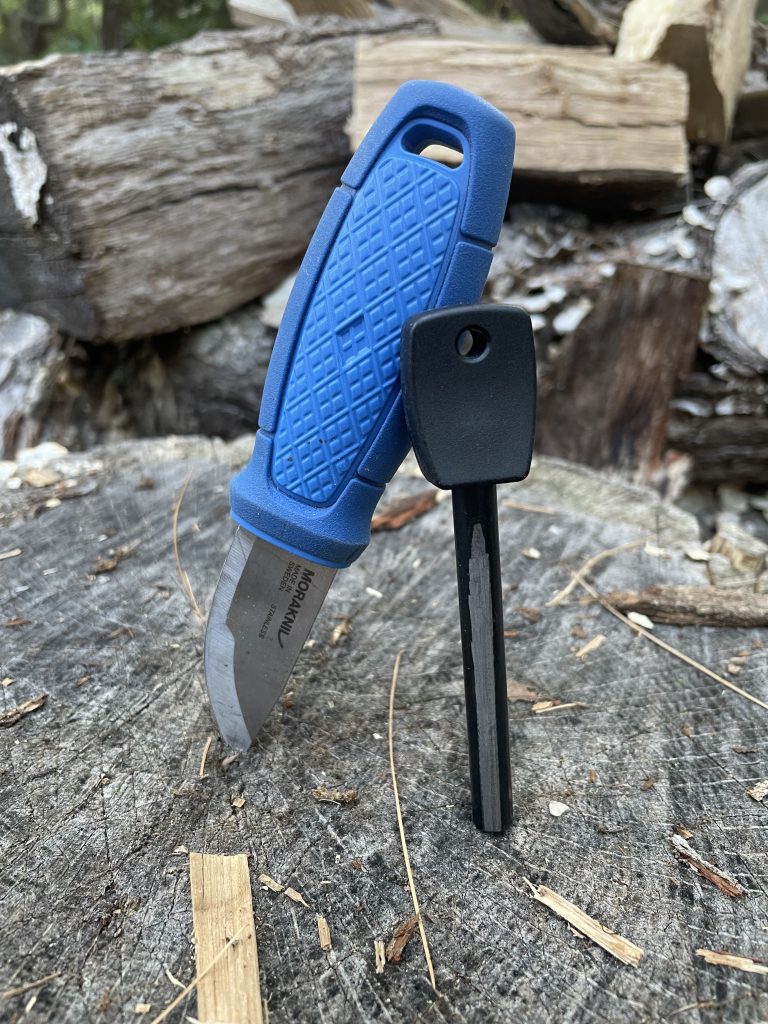
With so many creative ways to gather tinder from natural materials, there’s hardly any reason to waste your hard earned money on commercially available firestarters. All you have to do is think critically and get creative.
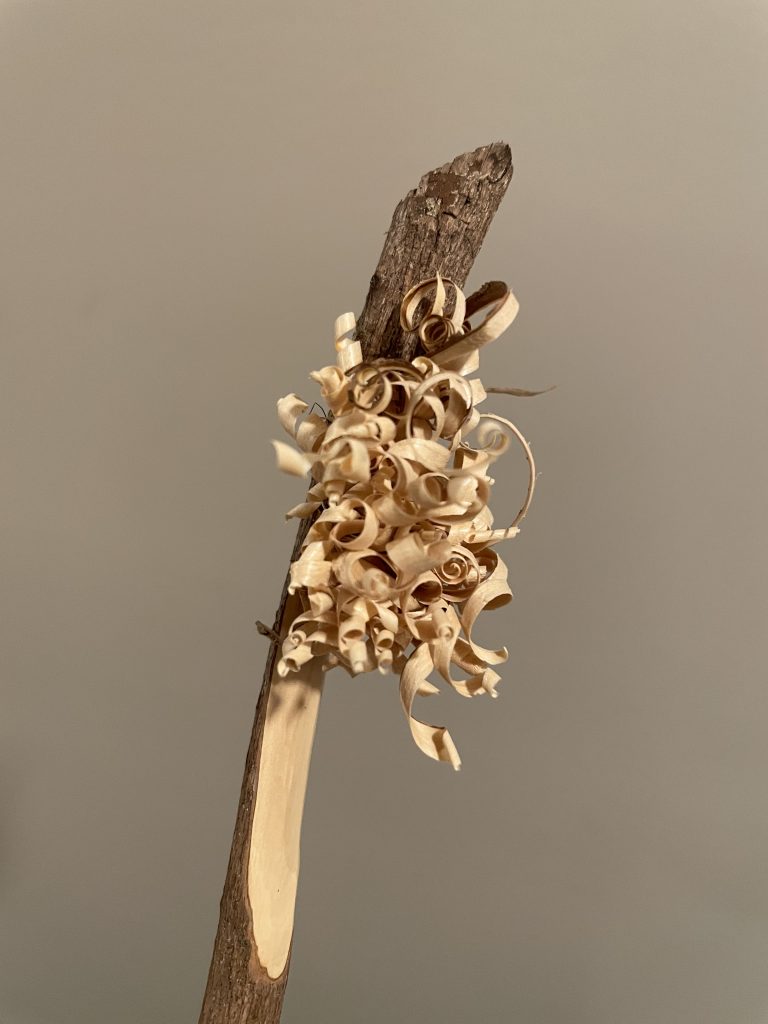
Perhaps you’ve seen one of these things. It’s called a featherstick and it’s a pretty convenient way to get a fire started off right. They light readily and since they’re carved from the wood you’re probably going to use for kindling and fuel anyway, they burn hot.
Learning to carve feathersticks is an invaluable bushcraft skill. The skill of carving feathersticks has been featured at least once in every survival blog and every outdoor publication I know of. There’s a catch, though.
They’re not particularly easy to carve. Making them effectively required the use of the right wood, with a dense, fine grain. It’s difficult to carve feathersticks from some woods. Your knife must have an appropriate grind and be well (and consistently) sharpened. If not, it will dive too deep into the wood or cut the shavings off at the end of each stroke.
The featherstick in the picture above is made from Rhododendron. We’re lucky enough to have some of these around the property and with its very dense, very tight grain, Rhodo branches make excellent featherstick practice.
But this is not a native shrub. I recognize that being able to make feathersticks on the fly is not always an easy task.
Nonetheless, you might be called on at some point or other to get a fire going quickly in a fix.
So let’s say you’re in the woods, at a campsite, perhaps, and you don’t have anything to use as tinder. For whatever reason, either you don’t have wood suitable for making feathersticks or you just don’t have the time or patience to make them. There is a much, much easier way.
As I was in the yard the other day, I was musing over the difficulty of creating reliable, viable featherstick and was looking for an alternative. I looked over to my stack of half-split, fairly well seasoned white oak (that I split with my Cold Steel Trail Boss) and thought – I need to be able to get a fire going out of that, and only that – preferably, with nothing more than a spark.
So as I pondered it over, I pulled out my Mora Eldris (pictured in this article), which I had been using to carve the feathersticks I was thinking over in the first place.
The knife has a square spine. White oak is dense, but often has a wavy grain, making it difficult to carve feathersticks.
But with the right tool, you can still get some nice shavings from the wood – and that’s exactly what I did.
My alternative to feathersticks in this instance will give you the ability to shave tinder directly off of the logs you plan to use as fuel, and all you need are a knife with a square spine and some fairly seasoned hardwood.
Tinder from Wood: Shavings That Light with a Spark
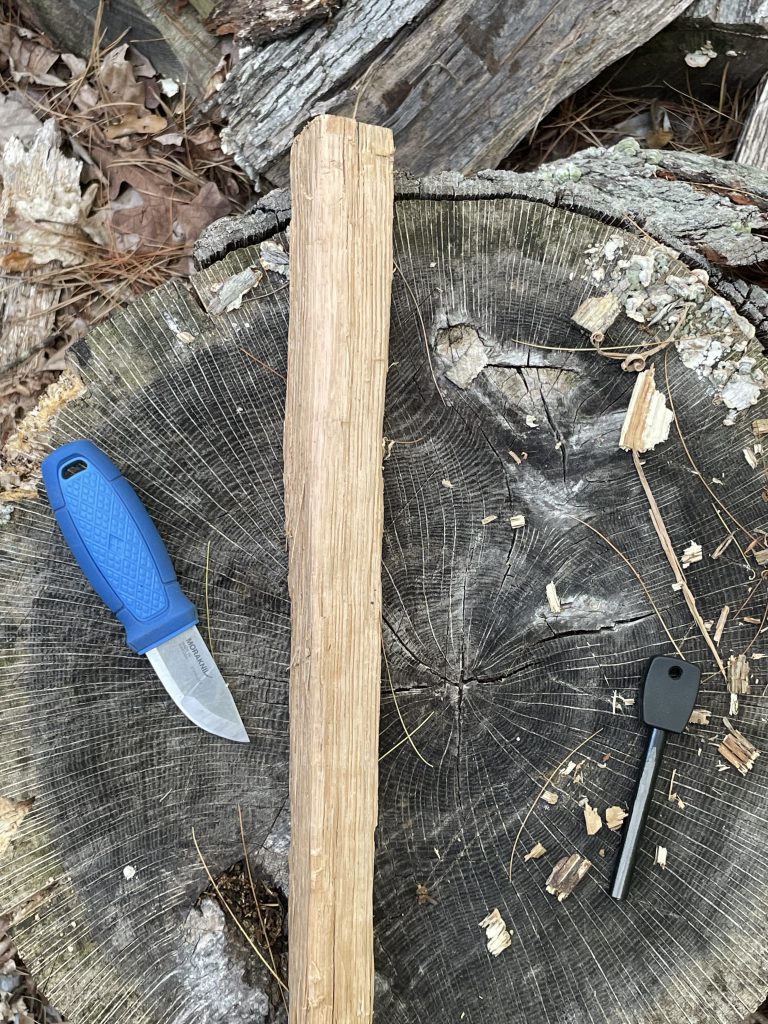
What you need to do here is use the spine to scrap very fine curls of wood off of the log you intend to use for the fire.
Sharp angles of split wood work best, because it’s easiest to scrape fine shavings off of these. Pick a nice piece of wood out of your pile. In this instance, I’m going to use a piece of white oak since I mentioned that above.
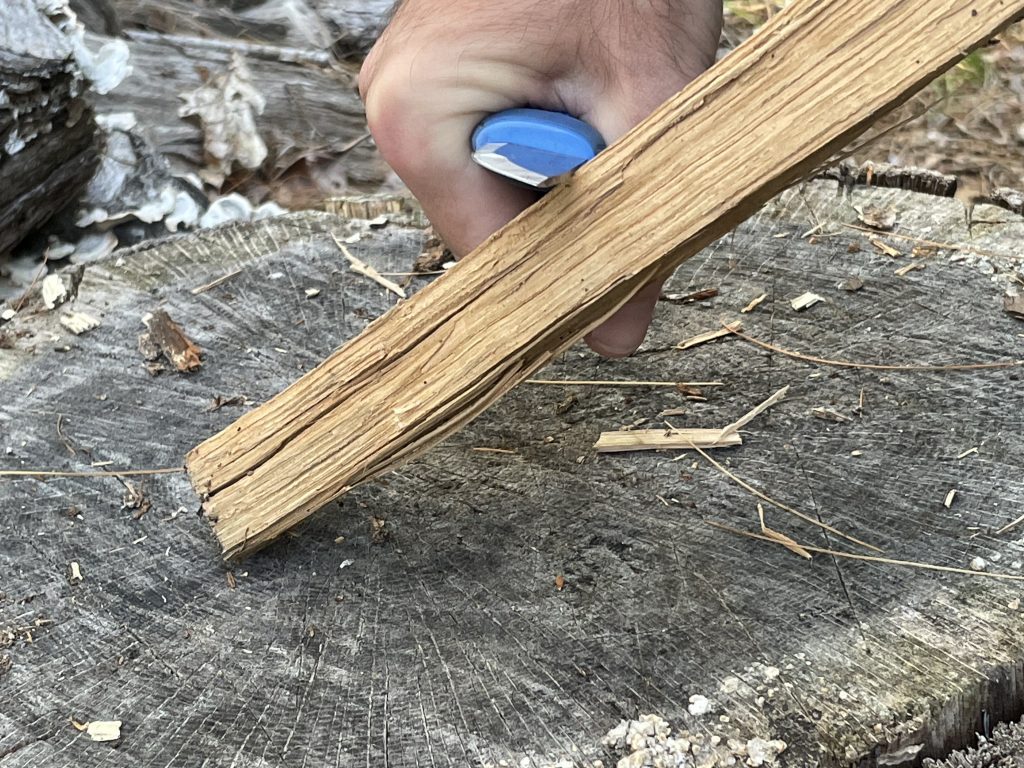
Brace the piece of wood against a chopping block or against a surface that’s clean, even and flat. That way you can gather your scrapings into a pile when you’re done.
Bring the back of the spine up against a corner of the log with your thumb braced against the flat of the knife. Angle the spine so that it contacts the wood at about 45°, as shown in the picture above.
Then, with a firm, strong stroke, push the spine obliquely downward over the surface of the piece of wood. If your angle ad pressure are good, a very fine curl will strip off of the wood. Repeat the process for a few strokes and see what sorts of shavings you’re producing.
These shavings need to be as light, springy, and airy as possible. You don’t want chips. These are too dense and will not light. You also don’t want big strips. If the shavings are think enough that they can’t be formed into a loose ball – almost like thread or dry grass – then they’re too thick.
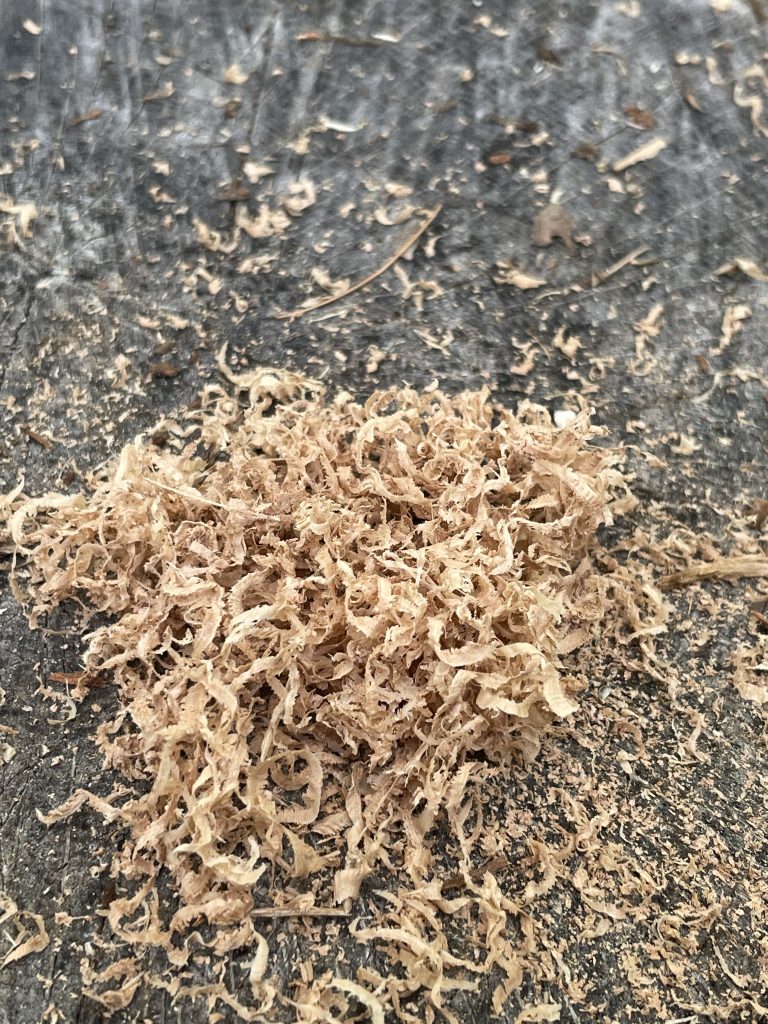
Tinder from wood – shavings, that is, needs to be extremely light, thin and airy, so that it can maintain its shape and allow oxygen to flow between the shavings. That’s one of the tricks to getting them to light with nothing more than a spark.
I’ve heard it said that you need enough tinder to make a full fist of it. Well, it’s hard to do that by making these shavings, and it takes a while. If you have that luxury, go for it. Make as big a pile as you need. The more, the better.
Otherwise, I say you scrape off enough to fit a nice, loose ball of it into the palm of your hand, as you can see in the picture above.
There are a few significant advantages to making this kind of tinder.
One is that you can do it almost anywhere, even in the woods in the rain. If you can find standing, dry timber, you can scrape off shavings. If you do it right, they’ll probably light, even if the woods are humid.
Another is that it is easy to do this. It requires effectively no skill or practice to master. What you need is a sure grip and a knife with a square spine – and, of course, some dry wood.
It’s also very economical and you can produce a fair amount of this stuff pretty rapidly. If you’re not used to making feathersticks, it can take a while to get them right.
Moreover, while you can get feathersticks to light from sparks, it’s not easy at all. They need to be very fine and very dense. The majority of the time, they won’t light from a spark. This tinder will.
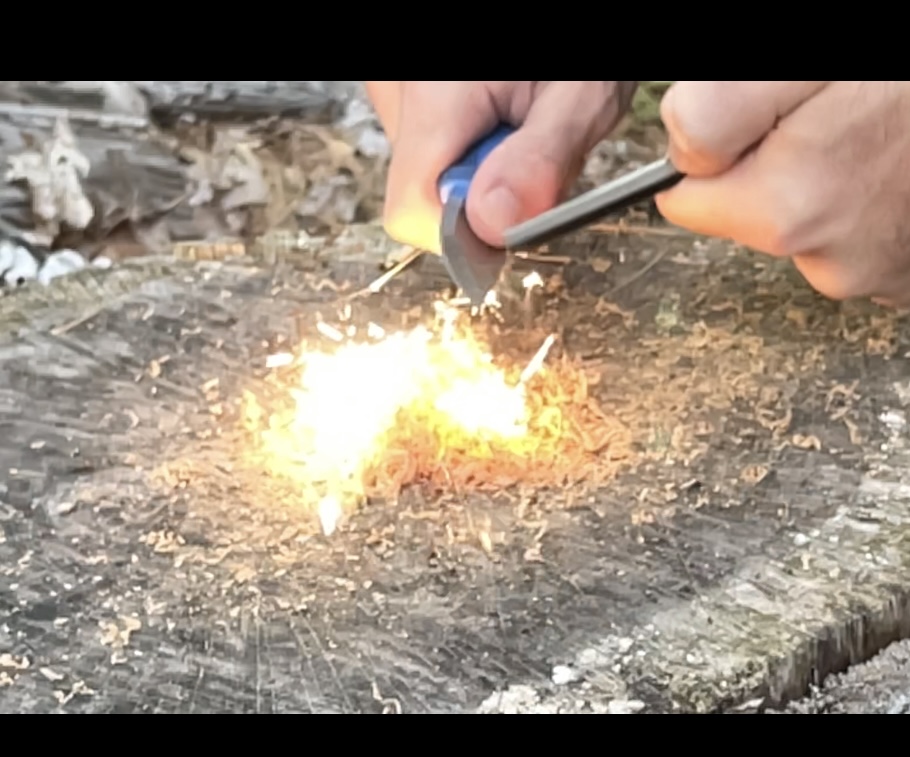
Moveover, most tinder doesn’t burn with a very hot flame. Since these shavings are made from wood, they will not only burn hotter, they’ll burn longer, giving you a better chance to get your flame to take. That’s a pretty big deal.
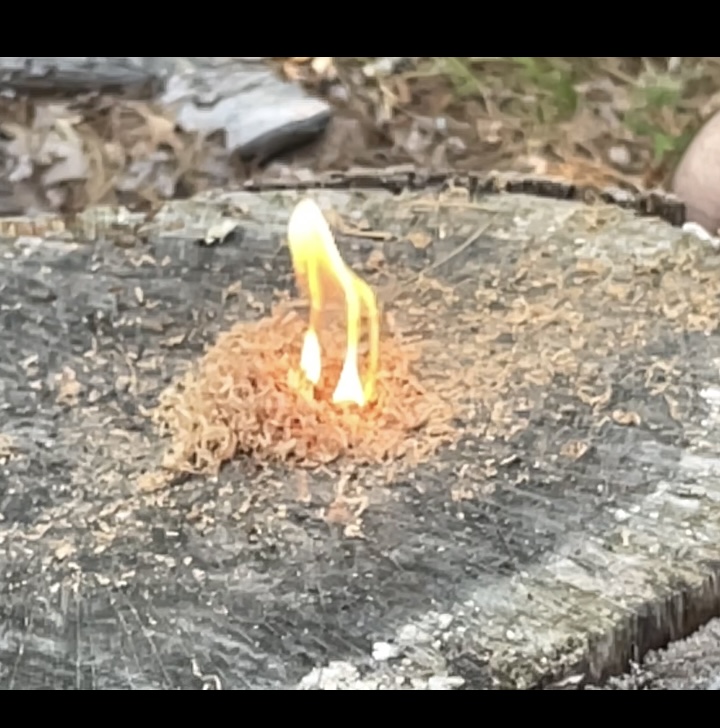
That’s basically all there is to it and all you need to know. So the next time you’re in camp and need to get a fire going but you don’t have (or can’t find) any tinder, take a piece from your fuel pile and scrape off some tinder. I’m confident it’ll quickly become one of your go-to tactics.
Perhaps this is the best part. It’ll keep you from ever needing to use the commercial stuff ever again. It probably works better anyway.
Be safe.
~The Eclectic Outfitter.